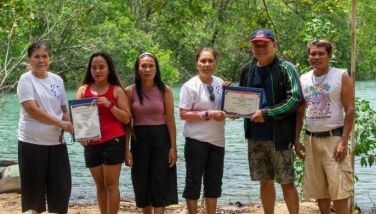Are there Martians among us?
August 17, 2006 | 12:00am
Nope, this isn’t Hollywood or tabloid stuff. Truth is, for years, scientists have been intensely debating and scrutinizing evidence that life forms from Mars may have flourished on Earth, way, way back before the dinosaurs or the pyramids! Scientists have been breeding and meticulously studying these alleged Martians for almost 30 years! In fact, zillions are bred in US, Europe and Asian facilities and some may have escaped from their breeding vessels! I swear this is not a hoax. Read on and you may realize that numerous species of these life forms may be gaining in numbers fast… right in your neighborhood!
Eleven thousand years ago, a piece of rock ejected from the surface of Mars landed in Antarctica. According to some scientists, the 4.5-billion-year-old Martian meteorite tagged as ALH84001, must have shuttled life forms from the red planet. Their evidence? Magnetic crystals aligned in chains embedded in the meteorite with striking resemblance to the composition and arrangement of magnetic crystals found within a group of bacteria thriving here on Earth called magnetotactic bacteria.
What are magnetotactic bacteria? An accidental observation on a routine, ordinary day, by an unknown and inquisitive graduate student of microbiology, led to a completely unexpected discovery of a unique group of microbes. While most of the young men of America were fighting in Vietnam and out in the streets getting high and yelling flower power in the early 70s, Richard P. Blakemore was busy peering under the microscope at bacteria from mud samples in a lab at the University of Massachusetts in Amherst. Rich wanted to isolate the microbes but he noticed something else… a strange kind of movement like that of a flock of birds or a school of fish. He observed a group of bacteria moving in unison! The cells swam in the same direction with high speed when a magnet was brought near the microscope. After repeated tests, he finally confirmed that the cells were, in fact, magnetically responsive. Rich’s discovery has evoked the interest of microbiologists, evolutionists, biochemists, physicists, geochemists, paleontologists, animal behaviorists, biotechnologists and astrobiologists worldwide! Rich shot to stardom in the scientific community, from serendipity and beyond!
Scientists so far have isolated magnetotactic bacteria from riverbeds, lakes, estuarine and marine waters. They found out that the magnetotactic behavior of the bacteria is due to the presence of nano-sized membrane-bound magnetic crystals of magnetite (Fe3O4) or greigite (F3S4) aligned in chains perpendicular to the cell axis. These highly organized structures are termed magnetosomes. For geochemists and paleontologists, they are referred to as magnetofossils. The geomagnetic field lines in the Northern Hemisphere are inclined downward, upward in the Southern Hemisphere, and horizontal in the equator. Correspondingly, magnetotactic bacteria thriving in these geologic locations migrate according to the inclination of the magnetic field lines. Hence, it is proposed that the magnetic particles function as navigating compass needles for the bacterium to migrate through the Earth’s geomagnetic field lines.
In 1996, NASA geologist David McKay and his group shook the scientific community by reporting the striking morphological and chemical similarities of magnetofossils on Earth and in ALH84001 strongly indicating that life existed in ancient Mars. Scientists opposing McKay’s theory demonstrated that the magnetic crystals in ALH84001 may have been formed by non-biological reactions. The recent evidence gathered by NASA’s rovers of the possible past existence of water, and hence, life in Mars, supports McKay’s claim. MacKay’s report has ushered a whole new school of thought that meteorites can transfer life between planets in space. If this postulation is true, a mind-blowing question pops up: where in the vast universe did we come from?
References:
1. Ronie J. Calugay, Hideaki Miyashita, Yoshiko Okamura, and Tadashi Matsunaga, Siderophore production by the magnetic bacterium Magnetospirillum magneticum AMB-1, FEMS Microbiol. Lett. 218 (2003) 371-375.
2. Ronie J. Calugay, Yoshiko Okamura, Aris Tri Wahyudi, Haruko Takeyama, and Tadashi Matsunaga, Siderophore production of a periplasmic transport binding protein kinase gene defective mutant of Magnetospirillum magneticum AMB-1, Biochem. Biophys. Res. Commun. 323 (2004) 852-857.
3. Ronie J. Calugay, Haruko Takeyama, Daikichi Mukoyama, Yorikane Fukuda, Takeyuki Suzuki, Kaneo Kanoh and Tadashi Matsunaga, Catechol siderophore excretion by the magnetotactic bacterium Magnetospirillum magneticum AMB-1. J. Biosci. Bioeng. 101 (2006) 445-447.
4. Takeyuki Suzuki, Yoshiko Okamura, Ronie J. Calugay, Haruko Takeyama and Tadashi Matsunaga, Global gene expression analysis of iron-inducible genes in Magnetospirillum sp. strain AMB-1. J. Bacteriol. 188(2006) 2275-2279.
5. Hiroko Yokouchi, Yayoi Fukuoka, Daikichi Mukoyama, Ronie Calugay, Haruko Takeyama1 and Tadashi Matsunaga, Whole Metagenome Amplification of Microbial Community Associated with Scleractinian Coral by Multiple Displacement Amplification Using _29 Polymerase. Environ. Microbiol. (In press).
Dr. Ronie Calugay recently obtained a Ph.D. in Life Sciences and Biotechnology from the Department of Life Sciences and Biotechnology, Tokyo University of Agriculture and Technology, Japan. He has a Master of Science in Microbiology (1997) from the University of the Philippines. He is currently a science writer (for English manuscripts) for the Matsunaga Laboratory, Department of Life Sciences and Biotechnology, Tokyo University of Agriculture and Technology, Tokyo (2003-2006). E-mail at [email protected]
Scientists so far have isolated magnetotactic bacteria from riverbeds, lakes, estuarine and marine waters. They found out that the magnetotactic behavior of the bacteria is due to the presence of nano-sized membrane-bound magnetic crystals of magnetite (Fe3O4) or greigite (F3S4) aligned in chains perpendicular to the cell axis. These highly organized structures are termed magnetosomes. For geochemists and paleontologists, they are referred to as magnetofossils. The geomagnetic field lines in the Northern Hemisphere are inclined downward, upward in the Southern Hemisphere, and horizontal in the equator. Correspondingly, magnetotactic bacteria thriving in these geologic locations migrate according to the inclination of the magnetic field lines. Hence, it is proposed that the magnetic particles function as navigating compass needles for the bacterium to migrate through the Earth’s geomagnetic field lines.
1. Ronie J. Calugay, Hideaki Miyashita, Yoshiko Okamura, and Tadashi Matsunaga, Siderophore production by the magnetic bacterium Magnetospirillum magneticum AMB-1, FEMS Microbiol. Lett. 218 (2003) 371-375.
2. Ronie J. Calugay, Yoshiko Okamura, Aris Tri Wahyudi, Haruko Takeyama, and Tadashi Matsunaga, Siderophore production of a periplasmic transport binding protein kinase gene defective mutant of Magnetospirillum magneticum AMB-1, Biochem. Biophys. Res. Commun. 323 (2004) 852-857.
3. Ronie J. Calugay, Haruko Takeyama, Daikichi Mukoyama, Yorikane Fukuda, Takeyuki Suzuki, Kaneo Kanoh and Tadashi Matsunaga, Catechol siderophore excretion by the magnetotactic bacterium Magnetospirillum magneticum AMB-1. J. Biosci. Bioeng. 101 (2006) 445-447.
4. Takeyuki Suzuki, Yoshiko Okamura, Ronie J. Calugay, Haruko Takeyama and Tadashi Matsunaga, Global gene expression analysis of iron-inducible genes in Magnetospirillum sp. strain AMB-1. J. Bacteriol. 188(2006) 2275-2279.
5. Hiroko Yokouchi, Yayoi Fukuoka, Daikichi Mukoyama, Ronie Calugay, Haruko Takeyama1 and Tadashi Matsunaga, Whole Metagenome Amplification of Microbial Community Associated with Scleractinian Coral by Multiple Displacement Amplification Using _29 Polymerase. Environ. Microbiol. (In press).
BrandSpace Articles
<
>
- Latest
Latest
Latest
October 24, 2024 - 11:20am
October 24, 2024 - 11:20am
October 14, 2024 - 11:00am
October 14, 2024 - 11:00am
October 11, 2024 - 12:49pm
October 11, 2024 - 12:49pm
September 30, 2024 - 8:00am
September 30, 2024 - 8:00am
September 26, 2024 - 2:00pm
September 26, 2024 - 2:00pm
September 3, 2024 - 1:00pm
September 3, 2024 - 1:00pm
Recommended






























